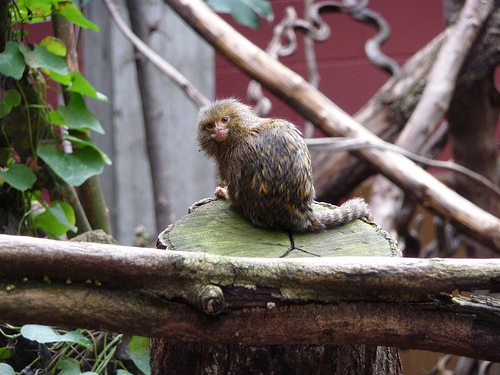Big things come in small packages, just like the pygmy marmoset.
- Pygmy marmosets are a species of small primate, endemic to the Amazon rainforest of northern South America.
- The scientific name of pygmy marmosets is Cebuella pygmaea, or the synonymous Callithrix pygmaea, and it is from the family Callitrichidae, a family of New World monkeys.
- At a height of roughly 12 to 16 centimetres (4.7 to 6.3 inches), and a weight of 85 to 140 grams (3 to 4.9 ounces), pygmy marmosets are among the smallest primates, and are the smallest living monkeys.
- A pygmy marmoset has fur patterned with a variety of colours, including browns, greys, whites, blacks and golds, and the tail is striped with dark coloured rings.
- The diet of pygmy marmosets consists primarily of tree sap or other resins, although they may also eat insects, fruit, spiders, nectar, flowers and lizards.
Pygmy Marmoset
Image courtesy of Karra Rothery/Flickr
- Pygmy marmosets have long tails of approximately 20 centimetres (7.9 inches) in length; and they live in trees and are excellent climbers, however they will rarely climb higher than 18 metres (59 feet) from the base of a tree.
- To collect sap from trees, pygmy marmosets gnaw small holes into the tree trunks, and they may create as many as 1300 holes in a single tree.
- Pygmy marmosets have high pitched calls comparable to that of bird calls, with some sounds being of a pitch too high for human ears to hear.
- While pygmy marmosets are listed as ‘least concern’, they are sometimes kept as exotic pets, however, the monkeys often perish from depression, or show considerable spite towards their owner.
- Pygmy marmosets generally have a lifespan of 8 to 12 years in the wild, and they live in family groups of two to nine individuals, and these groups are well-bonded.
Bibliography:
Pygmy Marmoset, 2016, A-Z Animals, http://a-z-animals.com/animals/pygmy-marmoset/
Pygmy Marmoset, 2016, San Diego Zoo, http://animals.sandiegozoo.org/animals/pygmy-marmoset
Pygmy Marmoset, 2016, Wikipedia, https://en.wikipedia.org/wiki/Pygmy_marmoset
Wade E, Callithrix pygmaea, 2012, Animal Diversity Web, http://animaldiversity.org/accounts/Callithrix_pygmaea/







